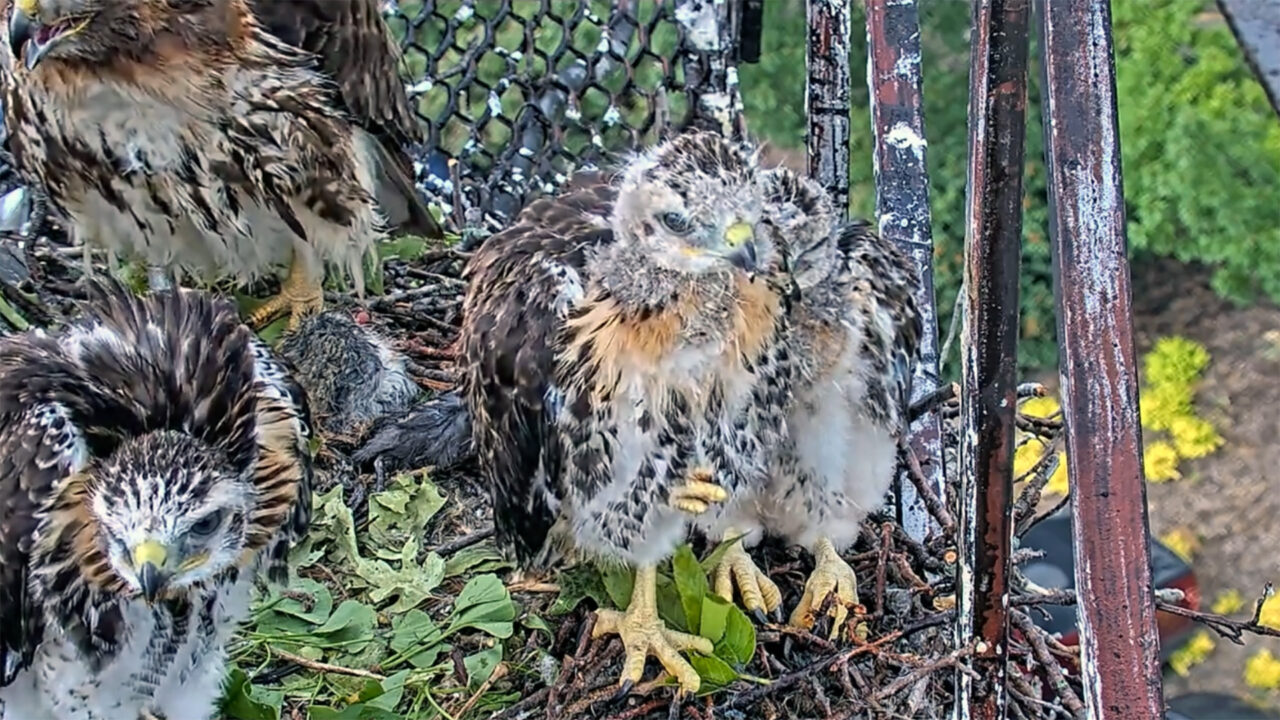Veterinary Evaluation at the Cornell Hawks’ Nest
June 11, 2023
Back in the Nest
June 11
All three nestlings are safe and back in the nest after a quick trip to Cornell’s Janet L. Swanson Wildlife Hospital this morning. Dr. Rolfe Radcliffe from Cornell University’s College of Veterinary Medicine went up in a lift with staff from Bird Cams and Cornell Facilities. A brief inspection confirmed that all three young had maggots in their ears.
The young were brought to the Wildlife Hospital where veterinarians noted mild tissue damage and inflammation. Veterinarians removed nearly 50 maggots, cleaned the young hawks’ ears, and provided the young hawks with fluids, antibiotics, and antiparasitic medication. Because the young were still in good health other than mild tissue damage, the prognosis is good.
Big Red, waiting on a nearby building, dove at the team while they returned the nestlings, a behavior that birds use in response to predators at their nest. She then perched on a nearby light tower to oversee the return of the chicks to the nest, and was soon joined by Arthur. Soon after the team descended from the nest, Big Red returned and began feeding the nestlings a chipmunk that Arthur had delivered while they had been away.
The Bird Cams team would like to give a heartfelt thanks to Dr. Radcliffe and Dr. Sara Childs-Sanford at the Janet L. Swanson Wildlife Hospital for their guidance and expert care. The keen observations of hawk cam volunteers “babynurse1” and “keys” raised awareness of the nestlings’ situation, and they were instrumental in collecting valuable video footage of the infestations during late-night cam operations. As always, Rich Barrows, Brian Becker, and Cornell Facilities were excellent partners in efficiently and skillfully getting us to and from the nest. Finally, thanks to the cams community for sharing their observations as well, and to the cam volunteer corps for providing great feedback and engagement with the community during and after the intervention.
Intervention Planned at Nest
June 10
After keen-eyed volunteers noticed an odd movement in the ear of M1 on June 8, veterinarians from the Janet L. Swanson Wildlife Hospital examined the footage and identified the cause as maggots in the ear. They noted swelling and that the chick is keeping its third eyelid over its eye, which is a sign of pain. If left untreated, the infection is expected to worsen. M2 also appears to be exhibiting the same condition. We worked as quickly as possible to arrange a lift to enable a veterinarian to perform an examination of the nestlings and treatment as needed. The exam will take place on Sunday, June 11, and we will provide updates once we know more.
Frequently Asked Questions
How did the Chick Get Maggots in its ear?
This sometimes happens in nesting raptors when parasitic fly larvae enter the ear of the chick. The length of time that the maggot is in the ear before it molts into a fly depends on the species.
For example, the blow fly Protocalliphora avium has been found on at least 12 species of North American raptors. It is a common parasite of Red-tailed Hawks in some regions. Short-term local studies showed sixty per cent of Red-tailed Hawk nests to be infested in southeastern Ohio but zero per cent in southwestern Ohio (Dkystra et al. 2012) and nearly one hundred per cent of nests near Ithaca, New York (Sargent 1938). The blowflies lay their eggs on nestlings, and the larvae can be found in ears, nostrils, and feathers. The larvae drop out of the ears when mature. Typically infestations of the ear do not damage the hawks’ hearing or health but heavy infestations, including when on more than one area of the body, can lead to weakness or death (Tirrell 1978).
What would happen if the chicks Are not treated?
While in the ear, the maggot feeds on the tissue, which can cause complications such as pain, infection, ear damage, and nerve injury. Additionally, if the chick is in pain or lethargic, it may not eat well, which could worsen its condition.

Bird Cams is a free resource
providing a virtual window into the natural world
of birds and funded by donors like you
Pileated Woodpecker by Lin McGrew / Macaulay Library